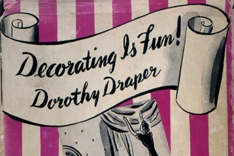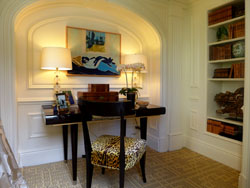Capturing Mood
 Alexia Rossetti
Alexia Rossetti  Wednesday, May 8, 2013 at 10:00AM
Wednesday, May 8, 2013 at 10:00AM 
Living Room by Bunny WilliamsAn important feature of a successful interior design is setting the mood. The mood can be warm and cozy, cool and light, fun and casual, or sophisticated and formal. In other words, the mood is what gives the room personality. Without mood, the room can turn out bland and forgettable.
How does an interior designer capture a mood? There are many tools that a designer can use. The easiest is the use of color. If you want to establish light and airy, the mood of spring, then you can use the colors of spring. In the living room above by Bunny Williams, she applied a color scheme of sky blue, bright yellows, greens and whites, a spring-like palette. Accessories are another tool used to establish mood. Ms. Williams used topiary and graphic prints of flowers to remind you of spring.
Bedroom by Catherine CleareIf you want to create a soft, romantic mood, then study designer Catherine Cleare’s ideas for a master bedroom. Cleare applied a variety of textiles to achieve her romantic look. She used soft cottons for the bed canopy and added ruffles to the vanity and bed linens. She also chose floral wallpaper to further the romantic effect. Lighting is also another tool which a designer employs to create a mood. Since a soft look is the goal, Cleare used several small lamps with linen shades to soften the light output.

Living Room by Joe NyeMany clients want a warm and cozy feel in their living space. To achieve this mood, Los Angeles designer Joe Nye applied a warm muted palette to his room. He used an orange raffia wall covering by Phillip Jeffries to add warmth and texture to the space. He chose dark woods for the furniture and mirror to give depth and warmth. He also chose a tufted sofa which is very inviting and added several pillows for the cozy touch.
Interested in learning more about interior design? Take a look at Sheffield School's Complete Course in Interior Design. At Sheffield, you will learn how to transform a space, create color schemes, and select furniture, lighting, and accessories.



Reader Comments (4)